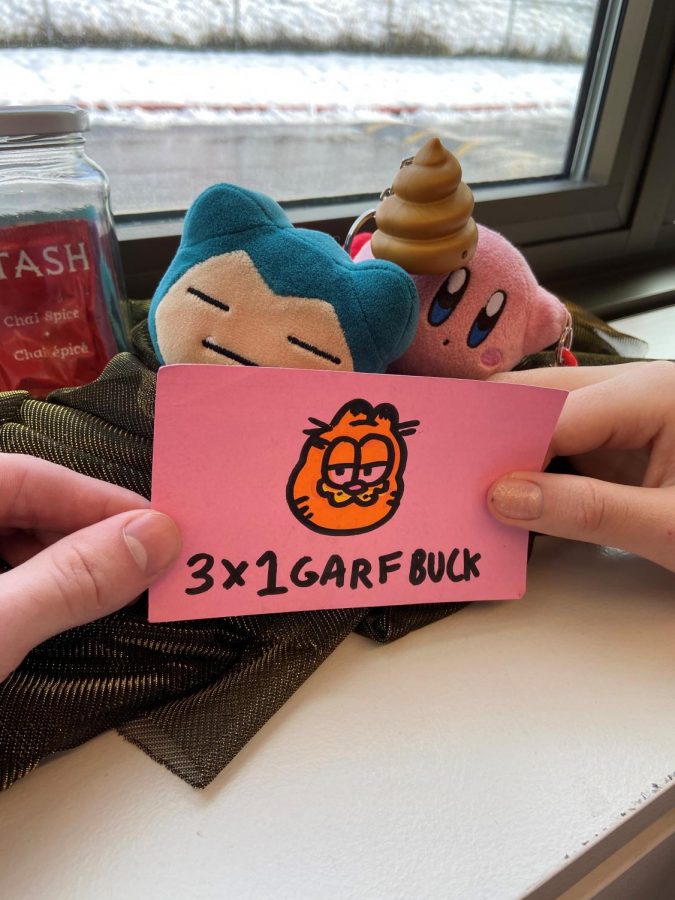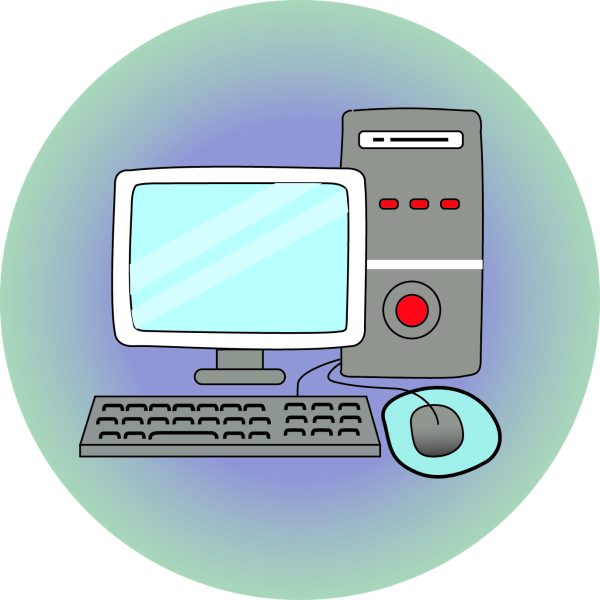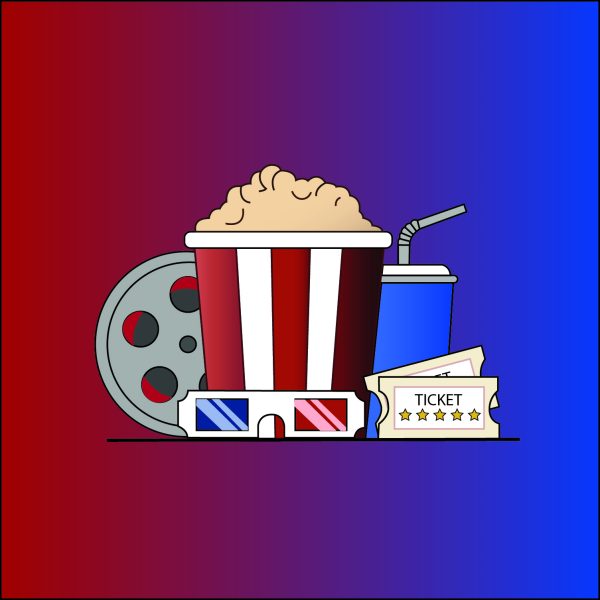Creating a Currency: Joy, Trinkets, and Garfbucks
January 22, 2020
2019 has been a stressful year. With impeachment, terrorism, controversies and cancellings, it has been absolutely packed to the brim. But at the same time, we repeat again and again this mantra about how stressful the year has been, and we have been doing this all the way back since 2016. What happened to easy? What happened to happy without the strings attached? Sometimes in this hectic world, I imagine a return to the simplest of simple systems: trading and bartering. I love to imagine being some merchant in a market, watching as people look at my many wares. I can imagine myself saying, “Yes, I will give you this bracelet for your chicken,” or “Two sheep for this ceramic dish-set? No way!” It is from this desire that I developed an idea for both an experiment and a passion project, just with a bit of a Jim Davis twist.
With the assistance of a Dollar Store set of notecards and some brand new markers, I set upon a mission to create my very own currency. First, like any good scientist and economics genius, I had to develop a hypothesis and a goal. That was the easiest part. What I wanted was to bring joy to others and to bring a revival to the trade and bartering system. There were multiple factors that I had to consider in this. How would I successfully market to my peers? What would the currency look like? What items would I be accepting? There was an endless number of things I could have done, so I decided to do some research in order to maximize this budding economy. In an experiment titled, “How Childhood Advertising Exposure Can Create Biased Product Evaluations That Persist into Adulthood” for the Journal of Consumer Research Paul Connell, Merrie Brucks and Jesper Nielsen wanted to find out whether buying decisions made by adults today, were skewed by their exposure to advertising as teens. What they found was that the subjects would remain “loyal” to the cereals that had a familiar childhood mascot associated with them, even after confronting their own biases. I needed a face for my currency that could be as iconic as a president on the American dollar, something that would draw in the eye of the average American teen with ultimate brand potential. That is when it hit me. The orange angel of modern-day teenage meme culture. He was both iconic and ironic, someone that anyone from Generation Z would recognize: Garfield. Garfbucks was the name of the currency, a tangerine shaded smug cat on the center of a colored notecard.
Now that I had the currency itself, I needed to decide how it was dispensed. I still wanted to uphold my trade and barter dreams, but how could I achieve that? Bartering is certainly not a dead act. In an article by NOVA on “The History of Money,” they wrote, “Barter is the exchange of resources or services for mutual advantage, and the practice likely dates back tens of thousands of years, perhaps even to the dawn of modern humans… Today individuals, organizations, and governments still use, and often prefer, barter as a form of exchange of goods and services.” I thought of a system that upholded the idea and spirit of trading, but still would involve the use of Garfbucks. I would act as a pawn shop; people would give me items for the Garfket (Garfbuck Market), and I would assess how many Garfbucks their items are worth. Then I would give them the decided amount and later, would open up the Garfket for the people, and let them choose the items they wanted and pay with the Garfbucks they earned. In order to get a seal of approval from an expert, I had AP Economics teacher Andrew Shanafelt review this system. Shanafelt said, “It certainly would qualify as a currency, especially if people are trading it and using it to purchase items. You obviously will need to overcome a trust gap in order for people to be like, ‘I will give you this for a Garfbuck because I will get something back later.’ What I find really interesting is that you are putting at stake your personal reputation with Garfbucks.” There are prices that need to be paid in order for people to reach new heights, and in this case, I was willing to pay the price.
Another way that I had to consider with Garfbucks was how I was going to promote it. Inspiration comes from many places, and I felt a calling towards nostalgia as the stage to present this new currency. From kindergarten to fifth grade, many schools had a system of positive reinforcement in the form of a “currency” that young students could trade in for trinkets. DECA student and junior Rachel Schovajsa discusses her elementary school money saying, “ I went to Cougar Ridge Elementary, they had something like that. It was like you did something good and you would get a Bobcat Buck, and there was like a little store you could access during lunch and you could buy things like lunch in the office or something cool like that.” This was an untapped market of nostalgia for most of the students I knew, and by presenting the Garfbuck similarly to how this system had been run in elementary school, hopefully I would be able to allow students to subconsciously return to that time of carefree freedom. It may seem immoral to exploit the childhoods of others, but according to Marketing Mag, “[People] want to enjoy something more visceral, surreal and surprising, so a little “grown-up playtime” is just what the doctor ordered. Many brands are helping provide that break from reality with experiential marketing that transports adults back to their youth and puts their stress in the backseat.” This is a practice fully used by brands and corporations, and if I wanted Garfbucks to bring joy, I would be willing to use many means to get there.
So how did Garfbucks turn out? Well, it could debatably be seen as a success. There were certainly some ways that I could have improved the system. Senior and Garfbuck-user Claire Mura recommended, “Maybe expanding the clientele and getting more items” and “the only issue is that there’s not a set exchange rate between items and Garfbucks.” I would keep this in mind for the next round. Talking to students across my seven periods, people submitted items and I got to learn about their histories. I was given a collection of animal bones, a pale shade and fragile to the touch. I was given a selection of metallic temporary tattoos, and I learned their past of Las Vegas vacations and learning to have street smarts. I was also given baby teeth–cleaned and sanitized, of course–and I learned about how they were lost and where they went after that allowed the students to still have them to this day. These little stories were then told to the buyers once the Garfket was opened. As buyers pursued my wares, I would retell them the histories of each item and who I received it from. I was satisfied, full of stories and joy that the system worked as it should. I was happy, but did that mean the currency was successful from the perspective of an economy teacher? Frank Reichlin, an Economy and World History teacher here at Issaquah said, “Are you happy with it? [If you are], then there you go, what [else] do you need? I think it’s a raging success.”
Just as I have put together this currency, I recommend that everyone does the same. Maybe not exactly what I did, spending three weeks with Garfbucks being the sole motivator in your mind, but finding other ways to spread joy with others and create something new. You never know what it will lead to, but if people are at least smiling on the way there, you can have hope that it will be something good.







Reuben Doyle-Newe • Jan 22, 2020 at 5:16 pm
Amazing article. Creating your own currency is so creative. I love it.